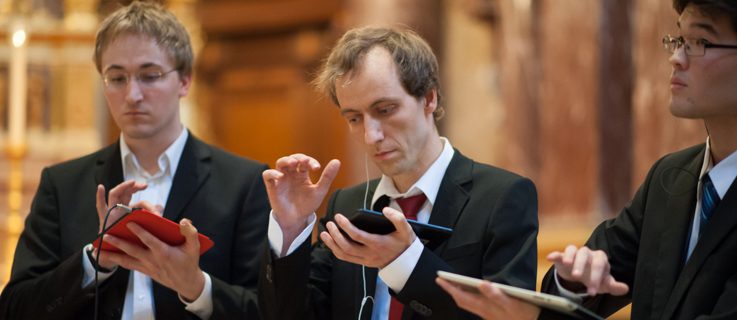Apps make smartphones and tablets into musical instruments. In the near future, musicians will swipe across displays instead of strumming strings.
When the iPad came on the world market in the spring of 2010, it was not yet clear what possibilities it would open. Music producers and creative folks, however, rubbed their hands together in glee, for the tablet promised the unprecedented mobility of sound design. Bands such as the Gorillaz, for example, relinquished big equipment during their tour of North America in the following autumn and recorded their album The Fall exclusively with about twenty different apps. Back then a novelty, now a matter-of-course.
Damon Alban's Gorillaz from "The Fall", the first album recorded on an iPad
Tablets and smartphones have developed rapidly into music production units. While initially the Apple operating system iOS and the apps designed for it were still in the lead in matters of user comfort and latency – that is, in the speed with which musical signals were implemented audibly, which is decisive in simulating the impression of musical instruments – Android devices scored better on connectors (USB, Midi) and combined hardware such as audio interfaces. Since then, however, the differences have become more and more equalized; in addition to Garage Band and FL Studio Mobile, the user now has the choice of thousands of constantly updated apps, whose functionality, for example, is discussed on Facebook forums such as “iOS Musician Blog” and “android music making”.
Mobile music making in self-experiment
And there is more. Music apps have become the object of research. Matthias Krebs heads the Music App Research Centre at the University of the Arts in Berlin, the teaching research project of DigiMediaL, and has already initiated conference such as
Mobile Music In The Making 2017 (MMM 2017), a meeting of specialists for music on mobile devices. “It’s a separate universe and the development is in its infancy. But alone what has been developed during the past few years in music practice, kinds of performance and possible applications is tremendous”, declares Krebs, who sees himself not only as a scientist but also as a creative, producing app musician.
“If you’re intensely occupied with music-making on a tablet, then several apps are constantly running simultaneously. There’s an app that records, and one that takes care of sound generation. Another chips in the effect devices, another takes over the function of the playback tape, and yet another records the whole thing, loops it and much more. In this advanced mode you can’t simply start an app and then you’re ready to go; you find an entire workshop there for digital instrument making.”
Pop of the future: the band out of the tablet
The spectrum of app design is constantly expanding. Many apps adapt themselves to the individual abilities of the user and enable both specialists and beginners to realize their sound ideas. There are apps as aids (metronome, tuner, note programme), apps for music-making and producing (effects, controller, synthesizer) and apps for music learning (listening training, learning to read music). Interface standards such as Ableton Link also facilitate the all-round collaboration amongst multiple musicians at the same time.
Mobile music making in concert: the Digi Ensemble performing Bach
Music apps in ensemble
“It’s the strength of music apps in practice to combine with other instruments. It’s not about pushing something around on the tablet in the coffee break, but rather connecting devices to a studio and using them extensively. There are now many musicians who build apps into their stage or rehearsal setting, as controller, sound generator or the like. The attraction is precisely to make music with others”, explains Matthias Krebs, who in 2010 therefore already founded the DigiEnsemble Berlin, which is dedicated to playing music, ranging from Bach to experimental sound installations, together with others on mobile devices. This is pioneer work and has met with varying degrees of recognition: “There are no composers in the classical field who compose works exclusively for tablets with music apps, but there are in pop. People like You Tuber Jakob Haq produce entire shows on the net, while others like Martin Neuhold make their own radio broadcasts.”
Haq Attaq, the mobile music channel of the Swedish You Tuber Jakob Haq
Just as the laptop changed the DJ cosmos, so smartphones and tablets have the potential to conquer the world of mobile music. First of all, because manufacturers are seeking distinctive tools that distinguish the one increasingly similar end devices from the other. Music and photography are the first choice.
Secondly, education has begun to discover music apps for fields ranging from music teaching to forms of motivation and language teaching, a development that also signifies a democratizing of the compositional process. The schoolchildren of today and tomorrow not only take quite naturally to the devices, but are also potential iPad composers, independent of academic, specialist musical training.
Thirdly, the inhibition threshold for learning an instrument on the smartphone in your pocket is much lower than with traditional instruments. And fourthly, habits change. In the United States, for example, the sale of electric guitars has fallen from 1.5 million instruments per years (2007) to less than one million (2016) (source:
Süddeutsche Zeitung). Traditional manufacturers like Gibson are in the red. Although acoustic guitars are still popular, smartphones and Bluetooth box around the camp fire may be the future.
